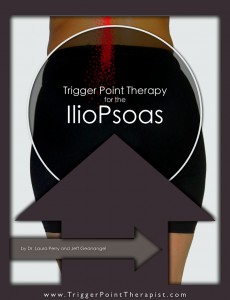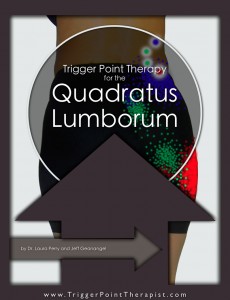Dr. Travell refers to the trigger points in the iliopsoas muscle group as the hidden pranksters of myofascial low back pain complaints, and rightly so. This muscle group lies deep in the abdominal cavity, out-of-sight and out-of-mind for many healthcare practitioners.
Though they rarely present as a single-muscle myofascial pain complaint, the iliopsoas trigger points frequently contribute to chronic low back pain cases, and must be addressed to effect a complete and lasting resolution of these cases.
Pain from these trigger points presents primarily as a deep ache that extends vertically along the lumbar spine and down into the sacroiliac joint. This pain referral may also have a groin component, and is typically worse in the standing position.
As a part of a comprehensive treatment plan, treatment of the iliopsoas trigger point(s) is straightforward and generally effective.
The Iliopsoas Muscle Group
The iliopsoas muscle group is composed of two muscles; the iliacus and the psoas major. The psoas muscle lies deep in the abdominal cavity, beneath the intestines. The iliacus muscle lies in the back of the pelvic cavity.
In everyday life, the iliopsoas muscle group functions to initiate forward movement of the leg during walking and running. It also helps to stabilize the lumbar spine during movements of the trunk. EMG studies of the muscle show that it’s active during “sit-up” exercises, with most activity occurring after the trunk has flexed 30° or more.
The psoas major muscle attaches superiorly to the T12 and L1-L5 vertebrae and intervertebral discs and runs diagonally downward and outward to join the iliacus muscle as it attaches to the lesser trochanter of the femur. The superior attachment of the iliacus is on the upper two-thirds of the inside surface of the ilium bone (iliac fossa).
The skeletal landmarks and muscular attachments of the iliopsoas muscle are shown in the video excerpt at the end of this article.
Contraction of the iliopsoas produces primarily hip flexion, though it may also assist lateral rotation of the thigh.
The Iliopsoas Trigger Points
The diagram below shows the primary trigger point in the iliopsoas muscle group.
Though, Dr. Travell identifies three possible trigger points in the iliopsoas muscle group, I frequently only address the one found in the upper iliacus fibers in my practice of trigger point therapy. The trigger point in the psoas major lies too deep in the abdominal cavity to release with pressure release techniques, though stretch-release techniques may be effective. In my experience, the lower iliopsoas trigger point (that lies near the muscles insertion on the lesser trochanter of the femur) is rarely present.
Iliopsoas Muscle Pain
The diagram above also shows the referred pain pattern associated with the primary iliopsoas trigger point. Beginning in the sacroiliac joint region, this pain extends in a vertical pattern along the lumbar spine to the base of the first rib. If only one iliopsoas is affected, the client will indicate their pain by moving their hand in a vertical movement along the lumbar spine. If both iliopsoas muscle groups have trigger point activity, the client typically run their hand across (horizontally) their low back to indicate their pain.
What Causes Iliopsoas Trigger Points?
The following events or activities may activate or reactivate the iliopsoas trigger point:
- Sudden falls
- Sitting in a jack-knife position (with the trunk and thighs close together) for long periods, as when driving or sitting on a soft, deep couch.
- Sleeping in the fetal position
- Pregnacy
- Performing sit-ups
IlioPsoas Symptoms & Disorders
Clients with active iliopsoas trigger points will present with any or all of the following symptoms or clinical findings:
- Low back pain that is worse in the standing position
- Low back pain has a vertical distribution, and may or may not have a groin component.
- Client may have a bent forward antalgic posture
- Hip extension aggravates the pain
- Pain may be experienced during a bowel movement
Treatment of Iliopsoas Trigger Points
For more information on the iliopsoas trigger points, as well as complete step-by-step directions for releasing the primary trigger point in this muscle group, you can purchase the Trigger Point Therapy for Iliopsoas Video Download or the Trigger Point Therapy for Iliopsoas Booklet for iPad.
Click on the image below to view an excerpt from the Ilio-Psoas Trigger Point video on YouTube:
Related Articles:
- The Quadratus Lumborum Trigger Points: Masters of Low Back Pain
- How to Release the Gluteus Medius Trigger Points (Video)
- Rectus Abdominis Trigger Points: A Six-Pack of Deception
- Trigger Point Therapy for Low Back Pain; Understanding the Complaint Within the Complaint
Related Instructional Videos:




